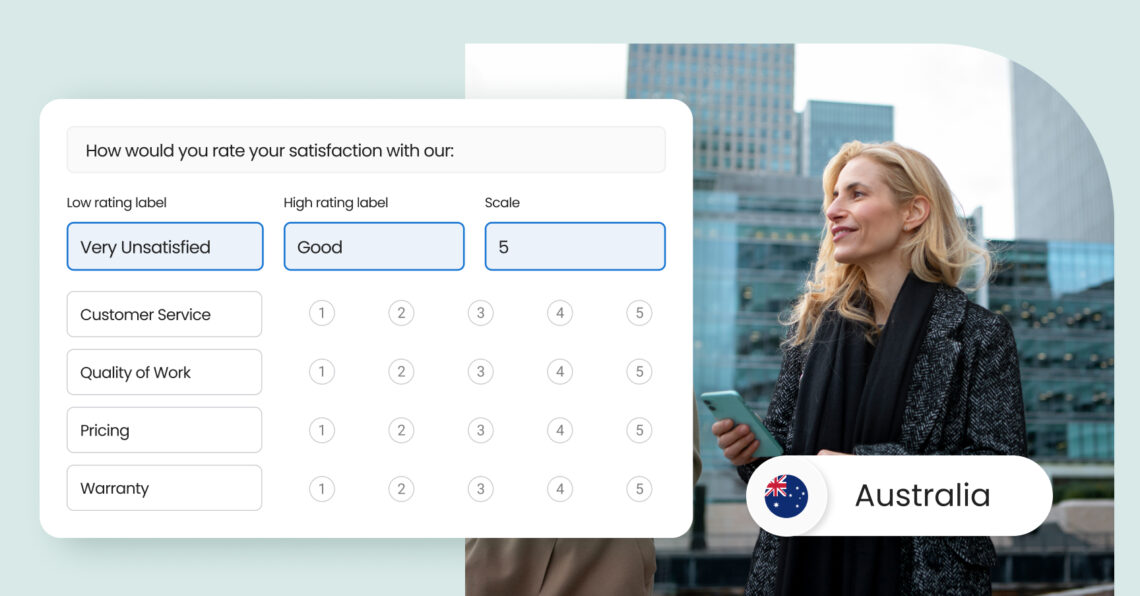In today’s competitive landscape, customer experience (CX) in Australia is no longer a “nice-to-have”—it’s a strategic necessity. Australian consumers are more informed and connected and expect consistent, relevant interactions. Businesses that meet these expectations are gaining a clear edge.
A focused CX strategy enhances customer satisfaction, loyalty, and overall business outcomes. More than ever, Australian companies increasingly treat CX as a measurable performance driver, making it a key part of their operations and competitive strategies.
In this blog, we’ll explore the state of Australia customer experience, why it matters, and how to build a successful CX strategy that directly impacts business performance.
Table of contents
- What is customer experience (CX)?
- Why customer experience matters in Australia
- CX strategy and management that works for the Australian market
- What is a good customer experience?
- What is a bad customer experience?
- Some great customer experience examples from Australia
- How Australian brands are using CX technology and software to scale personalised experiences
- How CX differs from customer service
- The business impact: sales, growth, and ROI
- Who is responsible for delivering the customer experience?
- Looking ahead: designing future-ready customer experiences in Australia
- Great experiences build great businesses
- Frequently asked questions on customer experience in Australia
- How Birdeye enhances customer experience strategy
What is customer experience (CX)?
Customer experience (CX) refers to a customer’s complete journey with a brand, from initial awareness to post-purchase engagement. It encompasses every interaction and touchpoint to deliver a seamless, enjoyable, and personalized experience at each customer lifecycle stage.
In the Australian market, CX spans several key areas:
- Website navigation: Australians value easy-to-navigate, fast-loading websites that allow them to find what they need quickly.
- In-store experiences: Whether in retail or service-based industries, Australians expect friendly, knowledgeable staff who can offer a personalized and efficient in-store experience.
- Customer service interactions: Australians seek prompt, helpful, and knowledgeable customer service across all channels, including phone, email, and social media.
- Product or service usage: After purchase, Australians expect products or services to meet their promises, with clear usage instructions and support available when needed.
- Post-purchase engagement: From feedback requests to loyalty programs, Australians appreciate brands that stay engaged with them after the sale to ensure satisfaction and encourage repeat business.
Why customer experience matters in Australia
A strong preference for service, convenience, and transparency delivers exceptional customer experiences in Australia. To remain competitive, businesses must align their CX strategies with these local expectations:
Personalized digital experiences
Australians expect brands to understand their unique preferences and offer tailored recommendations, whether through website content, emails, or mobile apps.
Fast and efficient service
Australians prioritize quick, no-fuss service. Customers value businesses that swiftly resolve issues and streamline online and in-store processes.
Trust and transparency
Honesty is highly valued in Australia. Customers want clear communication about pricing, delivery times, and service terms and expect brands to stand behind their promises.
Omnichannel convenience
Australian consumers expect a seamless experience across channels. Whether shopping online, interacting on social media, or visiting a physical store, they expect consistent service and the ability to switch channels without friction.
A single poor experience can lead to immediate customer churn in Australia, as consumers quickly voice dissatisfaction, especially on social media and review platforms. However, consistently positive experiences build trust, loyalty, and long-term advocacy. CX is a critical competitive edge in today’s market that can set a brand apart.
Note: Australian businesses must be mindful of the Australian Consumer Law (ACL), administered by the Australian Competition and Consumer Commission (ACCC), which ensures that consumer rights are protected. Adherence to these guidelines is crucial in maintaining customer trust, particularly regarding transparent pricing and delivering on promises.
CX strategy and management that works for the Australian market
To meet the expectations of today’s Australian consumer, businesses need more than good intentions—they need a clear, well-structured customer experience (CX) strategy. Australians value reliability, transparency, and personal service and are quick to support brands that consistently deliver on these fronts.
An effective customer experience (CX) strategy for the Australian market includes:
- Understand what matters most to your Australian audience—from service speed to value for money.
- Identify pain points across touchpoints—in-store, online, or post-sale—and address them with the local context in mind.
- Tailor interactions based on real behaviour and preferences, not just names and generic segments.
- Ensure everyone, from frontline staff to leadership, has a role in maintaining consistent experiences.
Australian businesses that succeed in CXM invest in the right tools and frameworks, scaling their efforts while still delivering personal, dependable, and local service.
Note: Businesses must comply with Australian Privacy Principles (APPs)under the Privacy Act 1988 to protect customer data. Non-compliance could result in fines and significantly damage customer trust.
What is a good customer experience?
Understanding what makes or breaks CX is essential. Here’s a quick comparison:
- Fast, helpful responses
- Consistent communication across platforms
- Easy-to-use interfaces
- Feeling valued as an individual
What is a bad customer experience?
Let’s understand here:
- Repeating the same issue to multiple agents
- Long wait times
- Inconsistent service or information
- Lack of empathy or personalization
Poor CX directly affects customer churn, online reviews, and brand trust, especially in markets like Australia, where customers have many options and high customer expectations.
Some great customer experience examples from Australia
Let’s look at how some Australian businesses are innovating through CX:
- A second-hand appliance store in Queensland used Birdeye to streamline communication and boost customer reviews by 350%, leading to a 10% increase in revenue. Consistent service and simplified feedback requests helped them enhance visibility and customer trust.
- Churchills Sports Bar adopted Birdeye’s all-in-one inbox and QR-based review process, resulting in a 350% surge in Google reviews and improved response times. Their CX upgrades led to stronger engagement and increased customer interactions across platform
s.
These examples show that the Australian customer experience does not have to be complex—it just needs to be intentional and aligned with customer needs.
Boost Customer Experience Australia Today
Want to see the impact of Birdeye on your business? Watch the Free Demo Now.
How Australian brands are using CX technology and software to scale personalised experiences
Personalisation has moved beyond using a customer’s name in an email. Australian brands leverage advanced CX technology to deliver timely, relevant, and contextual experiences at scale, across channels, and in real time. Technology enables a more intelligent and consistent customer journey from automation to AI-powered insights.
Businesses seeking bold, tailored customer experience solutions are increasingly looking at local vendors. That’s where customer experience solutions Australia come into play—tools and platforms purpose-built for local needs and customer preferences.
Here’s how leading Australian businesses are using CX tools and platforms to enhance personalisation:
Customer Data Platforms (CDPs)
Brands are centralising data from multiple sources to build unified customer profiles, enabling more targeted interactions and real-time decision-making.
AI and machine learning
Predictive analytics and AI are helping businesses anticipate customer needs, segment audiences more precisely, and deliver content that resonates on an individual level.
Automated customer journeys
Marketing automation tools trigger messages based on behaviour, preferences, or lifecycle stage, ensuring timely and relevant outreach.
Chatbots and virtual assistants
Many Australian companies use AI-powered chat to handle routine inquiries and collect data to refine the customer experience further.
Omnichannel platforms
Retailers and service providers are integrating channels to ensure customers receive a seamless experience, whether online, in-app, or in-store.Feedback and Sentiment Analysis Tools: Real-time listening tools help capture customer feedback and emotion, allowing brands to respond quickly and adjust their approach as needed.
By embracing these technologies, Australian organisations are meeting rising expectations and creating more meaningful and efficient customer journeys. The result? Stronger engagement, better retention, and measurable business growth.
How CX differs from customer service
While closely related, customer service is just one part of the broader CX puzzle.
Customer service is:
- Reactive
- Issue-focused
- Typically post-purchase
Customer experience is:
- Proactive
- End-to-end across the customer lifecycle
- Designed to prevent problems before they arise
In Australia, customers expect exceptional service and well-designed experiences. Brands that understand this distinction can build systems that reduce customer effort and increase satisfaction.
The business impact: sales, growth, and ROI
Investing in CX delivers measurable business outcomes. It’s not just a feel-good initiative—it drives business growth.
How CX impacts performance:
- Higher conversion rates due to better user experiences
- Increased customer retention and lifetime value
- More referrals and word-of-mouth marketing
- Lower service costs due to reduced complaints
Key CX metrics include:
- Net Promoter Score (NPS) – likelihood of recommending a brand
- Customer Satisfaction Score (CSAT) – satisfaction with a specific interaction
- Customer Effort Score (CES) – how easy it was to complete a task
Best customer experience companies in Australia that lead in CX tend to outperform competitors in revenue growth, customer loyalty, and brand equity.
Who is responsible for delivering the customer experience?
Customer experience is everyone’s responsibility—it must be embedded into the organizational culture.
Key roles include:
- Leadership sets the CX vision and strategy
- Marketing ensures consistent and relevant messaging
- Product and design teams craft intuitive experiences
- Customer service supports and resolves with empathy
- Data and IT manage the tech backbone of CX delivery
Some organizations appoint a Chief Experience Officer (CXO) or build dedicated cross-functional CX teams to ensure coordination and accountability across the business.
Looking ahead: designing future-ready customer experiences in Australia
The future of CX lies in creating human-centered experiences powered by intelligent emerging technology.
To build a future-ready CX strategy, Australian businesses should:
- Use AI and automation for efficiency
- Invest in real-time feedback systems
- Continuously update customer journey maps
- Create cross-channel consistency
- Combine empathy with analytics for meaningful insights
CX consulting services or strategic partners can also help identify blind spots, benchmark against competitors, and implement lasting improvements. This is particularly important in complex or highly regulated industries.
Great experiences build great businesses
In Australia, customer experience is crucial for any business’s success. From strategy and technology to people and performance, every part of an organization contributes to delivering the kind of experience customers remember and return for.
As competition intensifies and consumer expectations evolve, those who invest in CX now will be best positioned for long-term growth, loyalty, and leadership in their industry.
Frequently asked questions on customer experience in Australia
Australian customers value speed, transparency, and personalization, making seamless, digital-first experiences essential for retention.
Start by mapping key journeys, collecting feedback, and training teams to deliver consistent, empathetic service.
Yes, CX drives higher retention, increased spending, and stronger brand loyalty, making it a powerful growth lever.
How Birdeye enhances customer experience strategy
For Australian businesses looking to elevate their customer experience strategy, Birdeye helps businesses stay ahead by offering:
✅ Omnichannel messaging: Seamlessly connect with customers across SMS, email, web chat, and social platforms—all from one unified inbox. No message gets missed, no matter the channel.
✅ Automated surveys and real-time feedback loops: Collect feedback at the right moment to spot issues early, track sentiment, and close the loop quickly.
✅ AI-generated insights and responses: Save time and elevate communication quality with intelligent AI that summarizes reviews, flags issues, and suggests professional responses. This is perfect for businesses managing high feedback volumes.
✅ Review management at scale: Monitor and respond to reviews across platforms like Google, Facebook, etc, helping you build trust and improve your online reputation.
✅ Customer journey visibility: Map out and improve every customer touchpoint using actionable insights, survey data, and AI summaries of customer interactions.
✅ Social media amplification: Generate content ideas, schedule posts, and get hashtag recommendations to digitally keep your brand active and relevant.
As Australian consumers grow more discerning, Birdeye ensures your business is ready to provide them with the experience they expect and deserve.

Originally published









